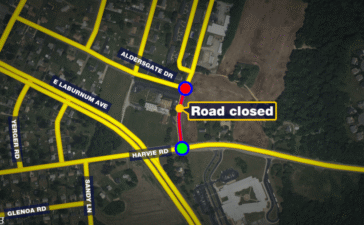
RICHMOND, Va. (WRIC) — After a winter storm brought snow to parts of Central Virginia on Wednesday, many may wonder how snowfall is officially measured.
According to 8News Meteorologist Matt DiNardo, to accurately measure snow, people will need a snowboard made from a thick sheet of plywood, usually 16 inches by 16 inches or larger, but always made in a square.
DiNardo said the snowboard should be painted white on both sides so that the sun’s light is more reflective rather than absorbed by the board, and be placed away from homes or buildings.
“A good rule of thumb is about 20 to 30 feet away from anything that can block the snowfall or something that can give off heat,” DiNardo said.
Once the snow falls, wait six hours and then take a ruler and measure the snow. According to DiNardo, snow is measured in tenths of an inch, however, most rulers are not built in tenths of an inch. You can convert the measurements by using the National Weather Service’s conversion chart.
After you have measured the snow, write down the measurement and clear off the board completely to allow the snow to accumulate again. Then, measure the snow every six hours through the end of the storm. The total of the all of measurements is the snowfall.
“So, for instance, if in the first six hours, you measured 3.2 inches and then in the next six hours you measured 7.8 inches, and then in the next six hours you measured 1.2 inches, then your total snowfall is 12.2 inches,” DiNardo said.
Even if the storm ends during one of those six hours, DiNardo said you still need to wait the full six hours before the final measurement.
“The importance of waiting six hours is to allow the snow to settle, this is especially important in dry, powdery, fluffy snow, like we just received,” DiNardo said.
If you want to know what your snow depth is, build a second snowboard and place it near the other snowboard. This board you do not clean off, but you measure the snowfall that has collected on the board only one time per day, usually at the same time of day.
According to DiNardo, the time of day to measure the snow is typically 12 Greenwich Meantime, or 12UTC, which converted to Eastern Standard Time is 7 a.m. DiNardo said this allows the snow to settle and melt each day.
“In the example that I used in measuring snowfall, and we received 12.2 inches over the course of a storm that was about 18 hours, you might find that your snow on the ground, snow depth, measurement is a little less than your observed snowfall because it has had time to settle,” DiNardo said.
Since most people do not have snowboards, DiNardo said for television and general weather reporting to the National Weather Service, people are asked to take measurements in three or four flat locations in their yard to get an average of those measurements for the snowfall.
“And truly we are not going to ask you to measure every six hours, because this is meant to be fun and we accept that there will be some errors in measurements when collected like this, but this gives us a good representation of roughly how much snow fell in an area,” DiNardo said. “The reason to take several measurements and get an average of those is to try to minimize any measurement that was taken in a snow drift caused by the wind.”






